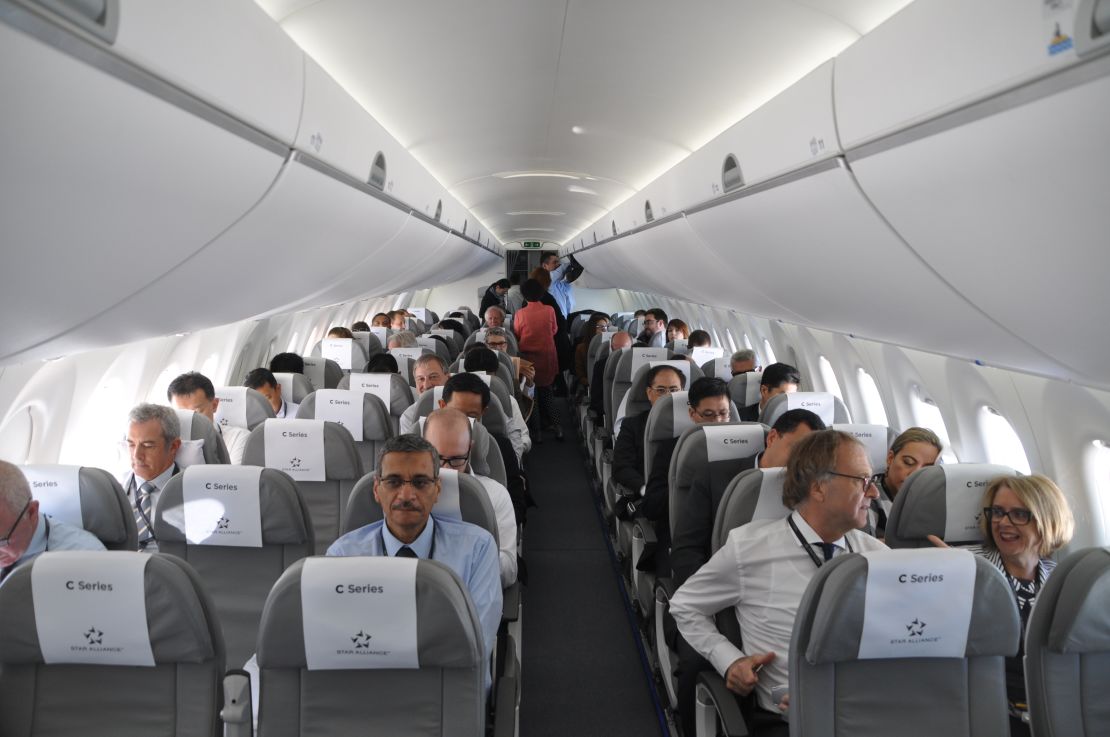Bombardier called the special SWISS airline flight “the most important take-off in the history of the CSeries.”
The CSeries CS100 is the first newly designed airliner of its kind in decades. SWISS flew the plane’s first passenger flight Friday from Dublin to Zurich. And we were aboard.
Also on board were about 100 passengers including CEOs from some of the world’s most important airlines – demonstrating support for an aircraft that’s not quite in commercial service yet. SWISS’ first CS100 commercial flight with paying customers is set for July 15.
Related story: Delta Air Lines orders 75 Bombardier CSeries jets
With the CSeries, Bombardier is attempting to challenge Airbus and Boeing in their bread-and-butter market of 120-160 seaters.
Outfitted with 118 seats in a single-class cabin, this flight didn’t offer the same cabin configuration that SWISS plans to roll out in July. That will boast 125 seats by the German manufacturer ZIM.
Here are some of the highlights of the CS100 and the journey:
It’s not a wide body, but it looks like one
The difference is striking between the compact appearance of the aircraft from the outside – almost like a regional jet – and the way the plane looks on the inside – like a wide body.

The cabin width of the CSeries is 10.7 feet (3.28 meters), while an Airbus A320, with one seat extra per row, measures 12.1 feet (3.70 meters).
High ceiling and big bins
With its 6.9 feet (2.11 meter) high cabin ceiling and huge overhead bins, it’s no wonder the interior of the CSeries feels like a wide-body aircraft.
Overhead space is sufficient for every passenger to bring a typical cabin bag and fit it in.
Seat layout
It comes in a unique 2-3 seat layout in every row, unlike Embraer’s 2-2 or Airbus and Boeing types’ 3-3 configuration.
This results in seats boasting a width of 18.5 inches, even 19 inches for the middle seat, while an A320 seat normally is 17-18 inches wide.
Business class would be in a 2-2 arrangement on the CSeries – with 20 inches of width.
Seats
Even the seats in the back feel much roomier than they do in the rear cabin of Lufthansa’s A320neo with just 29 inches of seat pitch. Bombardier advertises that 120 seats in a standard single class layout on the CSeries would offer a 32-inch pitch. SWISS plans to install 125 seats on its CS100s, with a pitch of 30 inches.
Windows
It was obvious that sunny afternoon how much light entered the cabin through the plane’s big windows, which are 50% larger than an Airbus A320. Also, Bombardier says the CS100’s aisle measures 20 inches – the widest found in twin-engine jetliners.
Engines and noise levels
The start up of its Pratt & Whitney geared turbofan engines takes four minutes. The pilot simply turns two switches on the flight deck’s middle console near the thrust levers.
As the CS100’s engines are in take-off setting, the noise in the cabin is only slightly louder than the famously quiet A380 which boasts major insulation inside its cabin walls.
“It’s 2 decibels quieter inside the cabin here even than on our new A320neos,” explained Lufthansa CEO Carsten Spohr while on board.
Power reserves
Take-off was very swift as Capt. Esteban Arias pulled up the aircraft rapidly, demonstrating its power reserves. He later pointed out that it’s these reserves that make it possible for the CSeries to serve airports with shorter runways.
Range
Once the flight reached cruising altitude, Rob Dewar, Bombardier’s general manager CSeries, pointed out that the aircraft has a range of almost 6,000 kilometers (3,700 miles).
“That would be enough to do Dublin to Montréal nonstop – and that’s in fact where we are going today,” he joked.
Then, Dewar mentioned that the 1 hour, 50 minute flight to Zurich would burn less than 2,900 kilograms (6,400 pounds) of fuel – “about 35% less than an Airbus or Boeing twin [engine jetliner] would need.”
Meanwhile, SWISS has announced it’s changing its original CSeries order. Until 2018, SWISS will operate ten CS100s and 20 CS300s – a larger model, with 145 seats.
The first aircraft in that order is due to arrive during the first quarter of 2017. This year, the carrier is expected to receive nine CS100s, with a total of eleven of both versions due next year and the remainder in 2018.
Andreas Spaeth writes for Miami-based AirwaysNews.com.
